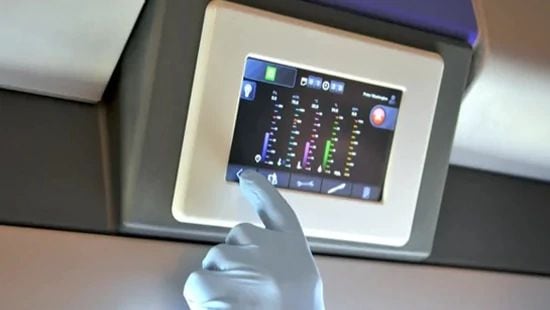How Does Vaporized Hydrogen Peroxide Decontamination Work?
Vaporized hydrogen peroxide, also referred to as Hydrogen Peroxide Vapour, is a solution that helps pharmaceutical and healthcare organizations more effectively decontaminate their facilities. In this post we break down what hydrogen peroxide vapour decontamination is and how it works.

What Is Hydrogen Peroxide Vapour?
Hydrogen peroxide vapour can be produced with a wide percentage range of hydrogen peroxide solution. This solution is flash vaporized into an enclosed space. For example, Bioquell Hydrogen Peroxide Sterilant (EPA Registration Number 72372-1-86703) constitutes a 35% solution to achieve a 6-log sporicidal kill on environmental surfaces when used according to the label instructions. It fills the entire space and covers every exposed hard, non-porous surface. This allows hydrogen peroxide vapour to fully contact irregular shapes that other manual cleaning methods and decontamination offerings can often miss.
How Does Hydrogen Peroxide Vapour Decontamination Work?
Let’s explore the Bioquell hydrogen peroxide vapour technology to better understand. These devices use a five-step process to automate the decontamination of surfaces.
Step #1: Setup
Before you can apply hydrogen peroxide vapour to a room, you’ll need to prepare the room for decontamination:
- Seal all vents or close the HVAC
- Remove linens and absorbent materials
- Position objects to minimise occlusion
- Open cabinets and drawers
After preparing the room, place the system and aeration units in the room. Close and seal the door upon exiting.
Step #2: Automated Vaporization
To get started, you may have to enter in room dimensions and details, use preselected settings or This vapour is then distributed homogenously throughout the target area using purpose-designed nozzles supported by on-board or stand-alone distribution fans. This will reach every exposed surface, including adjacent bathrooms, sluices and storerooms.
Step #3: System Safety Check
Once vaporization begins, the user checks the door to the room to ensure no leaks occur with the included handheld monitor. Leaks are rare as the process is not a pressurized one, and you can cover door gaps with adhesive tape.
Step #4: Dwell and Kill
With vaporization now complete, the enclosed area is at a standstill, allowing the peroxide to dwell on every exposed surface. This stage is crucial if you want to ensure efficacy against particularly tough organisms, like bacterial or fungal spores. It is important the product contact surfaces for the required time according to the directions for use.
Step #5: Aeration
At the end of each bio-decontamination cycle, the hydrogen peroxide vapour is catalyzed into harmless oxygen and water vapour. This can be achieved with the system’s onboard catalytic aeration or with additional aeration units assisting the breakdown. In some applications, this can also be accomplished using the facilities integrated ventilation system. The devices will convert the hydrogen peroxide vapour into water vapour and oxygen.
Once the space is aerated, no further cleanup is required. And after air levels are measured, the room is available for immediate reoccupation.
Why Do Pharma and Healthcare Facilities Use Hydrogen Peroxide Vapour?
The efficiency and efficacy of hydrogen peroxide vapour make it perfect for pharma and healthcare practices that need to decontaminate their facilities.
Pharmaceutical companies have strict requirements for spaces to maintain a certain level of cleanliness. Hydrogen peroxide vapour helps them efficiently eliminate microbiological contamination and reduce the risk of contaminating drug products. This supports compliance with regulatory agency requirements such as those from the FDA in the US and MHRA in the UK.
In the healthcare industry, hospitals need a way to kill or prevent the spread of organisms found in a clinical setting. Hydrogen peroxide vapour allows hospital staff to kill the organisms patients leave behind and help protect immuno-compromised patients. This is why Hydrogen peroxide vapour has gained even wider use during the COVID-19 pandemic as hospitals look for ways to better decontaminate their facilities.
Hydrogen Peroxide Vapour and Manual Cleaning
For compliance reasons, every pharma and healthcare firm has manual cleaning processes in place. Facilities that adopt hydrogen peroxide vapour often use it as the only microbiological decontamination step required in specific parts of their process due to its repeatability and validated cycles. When you combine hydrogen peroxide vapour and manual cleaning, you can consolidate cleaning steps and save time while adding a higher level of assurance to your process.
Why Hydrogen Peroxide Vapour?
The removal and risk management of contamination are key drivers in pharmaceutical and healthcare facilities.
Whether in response to a contamination incident, or to help minimise the risk of a contamination event occurring, large and small organizations need a reliable way to decontaminate their facilities, lab and manufacturing equipment and other enclosed spaces.
Hydrogen peroxide vapour decontamination is touch-free and completely automated. This makes decontamination procedures more repeatable and consistent.
And hydrogen peroxide vapour solutions work across a range of production environments including isolators, freeze dryers, biological safety cabinets, laboratory rooms and whole production/research facilities. This allows you to deliver the surety of a 6-log sporicidal kill to all exposed, hard, non-porous surfaces when used according to the directions for use.
Another benefit of hydrogen peroxide vapour is that it allows you to validate the decontamination process. The hydrogen peroxide vapour equipment provides pertinent cycle details of each procedure and a digital record of the decontamination. This is very useful in the event of an audit.
Conclusion
For organizations looking to increase the efficacy of their decontamination procedures, hydrogen peroxide vapour offers a reliable solution – whether standalone or supplemental. With 6-log kills, labour automation and process validation, hydrogen peroxide vapour can make decontaminating pharma and healthcare facilities easier than ever.



